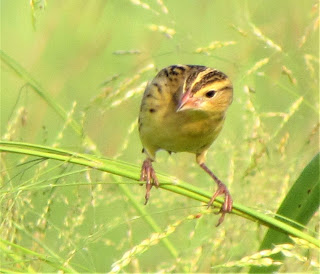October is always a hive of activity for local birders as we
all head north to the parish of St. Lucy in search of migratory birds. One must-see on most of our list is a small
bird, a champion of migration, the Blackpoll Warbler (Setophaga striata)*. This small bird makes a 12,400 miles (20,000
km) roundtrip each year, some crossing the entire North American continent
before making a nonstop trans-ocean flight for up to four days to South
America. Other than the Blackpolls, we saw
some other rare birds for the island.
Mega-Rare
- Ed Massiah reported a Wilson's Plover (Charadrius wilsonia) at Chancery Lane, Christ Church on the 5th. He also noted that one of the Whimbrels there was a European subspecies.
 |
| Black-headed Gull |
- A Black-headed Gull (Chroicocephalus ridibundus) was seen perching on the roof of a fishing boat moored at Pile Bay, St. Michael.
- On Wednesday afternoon of the 23rd, while out in the field with the University of the West Indies, Bio-diversity study students, we observed a Common Nighthawk (Chordeiles minor ), which flew directly over our heads.
 |
| White-winged Tern |
- A White-winged Tern (Chlidonias leucopterus) was seen from the 10th to 12th in St. Lucy. This may have been the same bird that was seen in St. Philip during September.
- A pair of Northern Shoveler (Spatula clypeata), the shovel billed duck, was seen in St. Lucy on
Rare
 |
| Hudsonian Godwit |
- Three Hudsonian Godwits (Limosa haemastica) sightings were reported in October. The first two on the 3rd at Chancery Lane and the 18th in St. Philip, were seen by John Webster and I saw the third on the 23rd in St. Lucy.
- A Juvenile Purple Gallinule (Porphyrio martinica) was discovered at Greenland, St. Andrew by John Webster on the 20th
- Bobolinks (Dolichonyx oryzivorus) in St. Lucy on 19th
 |
| Bobolinks |
Continuing Rares
 |
| Grey Heron |
- Grey Herons (Ardea cinereal) were seen in St. Lucy, St. Andrew, St. Thomas and St. Philip. This may have just been two birds moving around;
- Glossy Ibis (Plegadis falcinellus) in St. Lucy first seen in August;
- American (Caribbean) Coots (Fulica americana) has grown to 5 in total at Walkers Reserve, St. Andrew.
- A Brown Pelican (Pelecanus occidentalis) continues on the south coast. It was photographed by my niece at Carlisle's Bay.
 |
| American (Caribbean) Coots |
 v v |
| Blackpoll Warbler |
Notable Mentions: The
Blackpoll Warbler (Setophaga striata) migration is in
full effect and a few birds were seen in the latter half of October; Yellow-billed Cuckoos (Coccyzus americanus) were seen in St.
Lucy, St. Andrew and St. John during the month. The Pied-billed Grebes(Podilymbus podiceps) at Walkers are
continuing to grow in numbers – a visit to the reserve on the 26th tallied 10 birds, mostly adults. It was good to see the return of this bird to
St. Andrew.
As we move into November, rarity month, stay tuned to this blog for the most up to date local birding sightings.
*About Blackpoll migration and here

